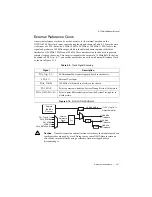
© National Instruments
|
2-7
ADC
The analog-to-digital converter (ADC) digitizes the AI signal by converting the analog voltage
into a digital number. The NI PXIe-4300 module has eight ADCs. Multiplexers (mux) are used
to select filter settings and to select external or internal sources for calibration.
Settling time refers to the time it takes the PGIA to amplify the input signal to the desired
accuracy before it is sampled by the ADC.
The PGIA can amplify or attenuate an AI signal to ensure that you use the maximum resolution
of the ADC.
Analog Input Data Acquisition Methods
When performing analog input measurements, you can either perform software-timed or
hardware-timed acquisitions.
Software-Timed Acquisitions
With a software-timed acquisition, software controls the rate of the acquisition. Software sends
a separate command to the hardware to initiate each ADC conversion. In NI-DAQmx,
software-timed acquisitions are referred to as having on-demand timing. Software-timed
acquisitions are also referred to as immediate or static acquisitions and are typically used for
reading a single sample of data.
Hardware-Timed Acquisitions
With hardware-timed acquisitions, a digital hardware signal (AI Sample Clock) controls the rate
of the acquisition. This signal can be generated internally on your device or provided externally.
Hardware-timed acquisitions have several advantages over software-timed acquisitions:
•
The time between samples can be much shorter.
•
The timing between samples is deterministic.
•
Hardware-timed acquisitions can use hardware triggering.
Hardware-timed operations can be buffered or hardware-timed single point (HWTSP). A buffer
is a temporary storage in computer memory for to-be-transferred samples.
•
Buffered—In a buffered acquisition, data is moved from the onboard FIFO memory of the
DAQ device to a PC buffer using DMA before it is transferred to application memory.
Buffered acquisitions typically allow for much faster transfer rates than HWTSP
acquisitions because data is moved in large blocks, rather than one point at a time.
One property of buffered I/O operations is the sample mode. The sample mode can be either
finite or continuous:
–
Finite sample mode acquisition refers to the acquisition of a specific, predetermined
number of data samples. Once the specified number of samples has been read in, the
acquisition stops. If you use a reference trigger, you must use finite sample mode.
















































